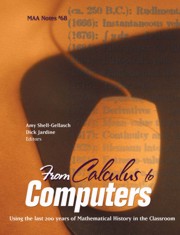Book contents
- Frontmatter
- Preface
- Contents
- Introduction
- I Algebra, Number Theory, Calculus, and Dynamical Systems
- 1 Arthur Cayley and the First Paper on Group Theory
- 2 Putting the Differential Back Into Differential Calculus
- 3 Using Galois' Ideas in the Teaching of Abstract Algebra
- 4 Teaching Elliptic Curves Using Original Sources
- 5 Using the Historical Development of Predator-Prey Models to Teach Mathematical Modeling
- II Geometry
- III Discrete Mathematics, Computer Science, Numerical Methods, Logic, and Statistics
- IV History of Mathematics and Pedagogy
- About the Authors
3 - Using Galois' Ideas in the Teaching of Abstract Algebra
from I - Algebra, Number Theory, Calculus, and Dynamical Systems
- Frontmatter
- Preface
- Contents
- Introduction
- I Algebra, Number Theory, Calculus, and Dynamical Systems
- 1 Arthur Cayley and the First Paper on Group Theory
- 2 Putting the Differential Back Into Differential Calculus
- 3 Using Galois' Ideas in the Teaching of Abstract Algebra
- 4 Teaching Elliptic Curves Using Original Sources
- 5 Using the Historical Development of Predator-Prey Models to Teach Mathematical Modeling
- II Geometry
- III Discrete Mathematics, Computer Science, Numerical Methods, Logic, and Statistics
- IV History of Mathematics and Pedagogy
- About the Authors
Summary
Introduction
Joseph Gallian [3, p. 47] in his popular text Contemporary Abstract Algebra states, “The goal of abstract algebra is to discover truths about algebraic systems (that is, sets with one or more binary operations) that are independent of the specific nature of the operations.” While this modern approach, because of its generality, provides a unifying element to the study of mathematics, it conceals from the student many of the great ideas generated by significant problems in the history of the discipline. B. Melvin Kiernan [4, p. 40] asserts that “without a clear historical perspective it is difficult to see or even imagine the connection between the [abstract] algebra of the present day and the computational problems from which it arose.” Similarly, John Stillwell [6, p. 143] in his book Elements of Algebra says that, “it seems to be one of the laws of mathematical history that if a concept can be detached from its origins, it will be.”
One approach to teaching a first course in abstract algebra that attempts to address the concerns raised by Kiernan and Stillwell without compromising sound pedagogy will be discussed here. In particular, this approach introduces the basic algebraic structures of group, ring, and field in a natural way using the theory of polynomial equations and the ideas of several mathematicians including Lagrange, Abel, and, especially, Evariste Galois. The historical problem of the solvability of polynomial equations provides a context for motivating the abstract structures as well as a link between this advanced course and elementary courses in algebra.
- Type
- Chapter
- Information
- From Calculus to ComputersUsing the Last 200 Years of Mathematics History in the Classroom, pp. 21 - 24Publisher: Mathematical Association of AmericaPrint publication year: 2005
- 1
- Cited by



